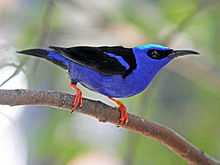Honeycreeper
| Honeycreeper | |
|---|---|
 | |
| male Red-legged Honeycreeper. | |
| Scientific classification | |
| Kingdom: | Animalia |
| Phylum: | Chordata |
| Class: | Aves |
| Order: | Passeriformes |
| Family: | Thraupidae |
| Genus: | Cyanerpes Oberholser, 1899 |
| Species | |
|
Four, all classed as Least Concern | |
The typical honeycreepers are small birds in the tanager family. They are found in the tropical New World from Mexico south to Brazil.
They occur in the forest canopy, and, as the name implies, they are specialist nectar feeders with long curved bills.
The four Cyanerpes species have colourful legs, long wings and a short tail. The males are typically glossy purple-blue and the females greenish.
The Green Honeycreeper is called a Honeycreeper, but belongs to the monotypic Chlorophanes genus. It has a larger, stouter beak than the Cyanerpes group, and is less heavily dependent on nectar. The Golden-collared Honeycreeper, is also a honeycreeper, but is monotypic in the genus Iridophanes.
Eggs
A commonly repeated, yet false, belief about the various Honeycreeper species is that some of them lay black eggs.[1] This idea was first made known in the scientific community with the 1899 publication of Nehrkorn's egg catalog; Nehrkorn's claim was cited in ornithological literature for many years without verification, but by the 1940s it was established that none of the members of Cyanerpes lay such eggs.
Species
- Short-billed Honeycreeper, Cyanerpes nitidus
- Shining Honeycreeper, Cyanerpes lucidus
- Purple Honeycreeper, Cyanerpes caeruleus
- Red-legged Honeycreeper, Cyanerpes cyaneus
References
- ↑ Eugene Eisenmann (1953). "What Bird Lays Black Eggs?". Auk 70 (3): 362–363. doi:10.2307/4081327.
External links
| Wikimedia Commons has media related to Honeycreeper. |
- Honeycreeper videos, photos and sounds on the Internet Bird Collection